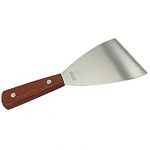The utensils for the preparation of fruit pastes
The preparation of fruit pastes requires little material but it should be effective, easy to clean and heat resistant.
For an artisanal production you will need:
Main utensils |
|---|
A SaucepanPrefer a thick bottom pan for a good hold of it. Indeed the more the bottom is thick and less the pan will deform with Be that as it may, avoid non-stick coatings that have a fairly poor performance over time. If you find an un tinned copper pan, do not hesitate it’s perfect. This type of pan supports intensive use and is of excellent thermal conduction plus the raw copper will promote the exchange of ions with the acid of our fruits which will bring a certain and natural antiseptic power. Depending on the amount of fruit paste you want, avoid a pan too big or too narrow. A thickness of 5 to 7 cm of products in the pan is a good amount. |
A ThermometerCooking requires a fairly precise temperature measurement. Baking a fruit paste at 107 ° C or 110 ° C does not After various tests, it turns out that the thermometers incorporated in the spatulas are not very accurate and have the unfortunate disadvantage of placing the electronics above the pan thus exposing it to steam and heat. In principle, a probe thermometer will be more accurate and only the probe will be in the pan. Moreover the electronics embedded in this kind of product is much more efficient. Often are integrated, a timer, a temperature alarm, memories etc. etc. |
A Spatula
No wooden spatula. Choose the robust and resistant to at least 200 ° C. Exoglass® spatulas are very effective and will allow you to easily scrape the bottom of the pan without damaging it. |
A MoldIn view of the quantities produced, we can use a rectangular or square mold not too big to keep a certain thickness to the product.Make tests, if you produce 1 kg of fruit paste, make sure to pour it into a container or the thickness will reach about 2 cm.If you have a marble and rules it’s even better. You will be able to perfectly adapt the thickness to the quantity produced. |
A Classic ScaleThe scale will have to manage the tare and be as precise as possible. Opt for a model resistant to water and heat and that does not go out every 30 seconds. If this one is sufficiently precise, you will be able to do without a scale of precision but you will have to pay expensive for that. |
A Precision Balance
|
Grout ColanderSince fruit purées must be smooth and without pieces (see article on fruit preparation ), a coulis will quickly become an essential accessory. Choose the stainless steel it will be easier to clean. Pay attention to the size of the grid that should be fine enough to stop small pips (raspberry, blueberry, grapes, blackberries, blackcurrant etc …) but wide enough to let the flesh. |
Some graduated pots or containersSince before you start your recipe, all the food involved will have to be ready, you will need some containers. If they are graduated it is even better. Some may be plastic. This is particularly the case for the one that will be used for the glucose syrup and which will have to pass in the microwave. |
Grout ColanderSince fruit purées must be smooth and without pieces (see article on fruit preparation ), a coulis will quickly become an essential accessory. Choose the stainless steel it will be easier to clean. Pay attention to the size of the grid that should be fine enough to stop small pips (raspberry, blueberry, grapes, blackberries, blackcurrant etc …) but wide enough to let the flesh. |
A Refractometer at 90 ° BrixChoose a model up to 90 ° Brix, easy to clean and adjust. Some of these instruments and utensils are of course indispensable, the pan, the spatula. Others less, the balance of precision, the pots graduated. But in any case think of their cleaning which will have to be very rigorous. |

 time. The thick bottom will also promote the circulation of heat. In this respect copper is an excellent conductor which will ensure that the temperature of the bottom of the pan will be the same as on the edges or almost. Also think about cleaning and maintenance. A tinned copper is quite fragile to intensive scrubbing whereas stainless steel or un tinned copper not at all.
time. The thick bottom will also promote the circulation of heat. In this respect copper is an excellent conductor which will ensure that the temperature of the bottom of the pan will be the same as on the edges or almost. Also think about cleaning and maintenance. A tinned copper is quite fragile to intensive scrubbing whereas stainless steel or un tinned copper not at all. have the same effect at all.
have the same effect at all.
